Exam (elaborations)
2020 HESI Medical-Surgical LPN/PN Nursing V1
- Course
- Institution
2020 HESI Medical-Surgical LPN/PN Nursing V1 Question 1 The nurse is providing care for a patient who is unhappy with the health care provider’s care. The patient signs the Against Medical Advice (AMA) form and leaves the hospital against medical advice. What should the nurse include in the doc...
[Show more]












